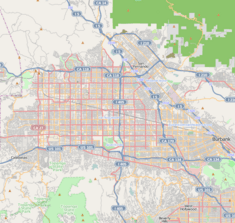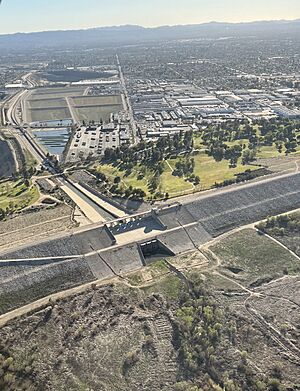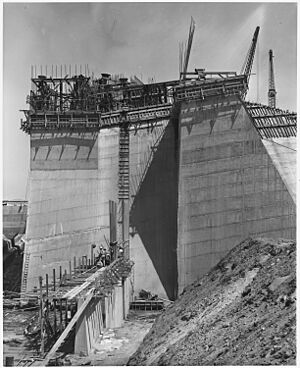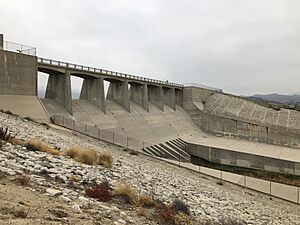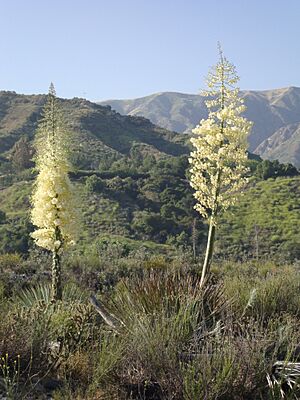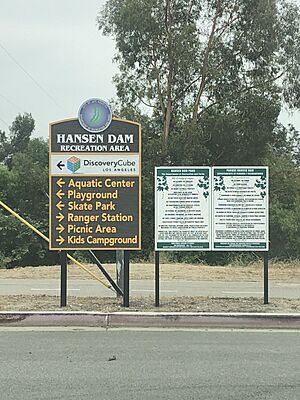Hansen Dam facts for kids
Quick facts for kids Hansen Dam |
|
|---|---|
 |
|
|
Location of Hansen Dam in United States San Fernando Valley
|
|
| Country | United States |
| Location | San Fernando Valley |
| Coordinates | 34°15′38″N 118°23′08″W / 34.26047°N 118.38556°W |
| Purpose | Flood control |
| Status | Operational |
| Construction began | 1939 |
| Opening date | 1940 |
| Owner(s) | |
| Dam and spillways | |
| Impounds | Tujunga Wash |
| Height | 97 feet (30 m) |
| Length | 2 miles (3.2 km) |
| Reservoir | |
| Total capacity | 74,100 acre⋅ft (91,400,000 m3) |
| Website Corps Lakes Gateway - Hansen Dam |
|
Hansen Dam is a large dam located in the Lake View Terrace area of Los Angeles, California. It was built to help control flooding in the northeastern San Fernando Valley. The U.S. Army Corps of Engineers finished building the dam in 1940. It got its name from Homer and Marie Hansen, who owned a horse ranch there a long time ago. Today, the Hansen Dam Recreation Center offers many fun activities in the area around the dam.
Contents
Where is Hansen Dam Located?
Hansen Dam is in the San Fernando Valley on the Tujunga Wash. The Tujunga Wash is a stream that starts between the San Gabriel Mountains and Verdugo Mountains. The dam is about 1 mile (1.6 km) downstream from where the Big Tujunga Creek and Little Tujunga Creek meet.
The dam has a large reservoir area that can hold water, sometimes called Hansen Lake. This area is about 1,300 acres (526 hectares) big. The dam's main structure, including where water can flow out, is in the middle of its rock wall. This wall curves slightly, connecting hills on both sides to form a natural barrier.
Why Was Hansen Dam Built?
History of Flooding in Los Angeles
In 1938, a huge flood hit Los Angeles, causing a lot of damage, especially along the Tujunga Wash. This event made people realize they needed better ways to control the city's rivers and creeks. The Los Angeles County Flood Control District had already been thinking about flood control since 1915.
Building the Dam
Because of the repeated floods, the U.S. Army Corps of Engineers started building Hansen Dam in 1939. They worked with the Los Angeles County Flood Control District. To build the dam, the Corps bought the horse ranch owned by Homer and Marie Hansen.
The dam took one year to build and cost over $11 million at the time. It is 2 miles (3.2 km) long and 97 feet (30 m) high. Its main job is to catch and control runoff and floodwaters.
How the Dam Helps with Water
During heavy storms, the dam holds back water in its reservoir. This helps prevent floods downstream. The dam also helps save water. It can release water slowly onto special "spreading grounds" south of the dam. Here, the water soaks into the ground, refilling underground water supplies that the city uses for drinking water.
Over time, dirt and debris from floods built up in the reservoir, reducing how much water it could hold. In 1981, there was a plan to make the dam taller, but it didn't happen. Instead, the Corps of Engineers regularly cleans out the sediment and debris to keep the dam working at full capacity.
Hansen Dam Recreation Area
The Hansen Dam Recreation Center and Park offer many activities for visitors. The City of Los Angeles Department of Recreation and Parks manages these facilities. You can usually get there from Highways 5 or 210.
Fun Activities at the Dam
- Lakes: There is a moderate-sized lake filled with clean drinking water. You can go fishing and boating there. It's open most of the year, but might close for bad weather or special events. There's also a smaller swim lake with filtered and chlorinated water, which can hold up to 2,800 swimmers. Lifeguards are on duty at all three lakes.
- Sports and Play: The park has picnic tables, barbecue pits, and play areas for children. You can also find baseball diamonds and soccer fields.
- Trails: There are trails for horseback riding and walking. These trails connect to others in the nearby Angeles National Forest. You can also walk along the top of the dam.
- Nature: The area has natural habitats like chaparral woodlands and riverside areas. A large part of the park is kept natural to protect plants and animals. Efforts are being made to remove unwanted plants and bring back native ones.
Discovery Cube Los Angeles
The Discovery Cube Los Angeles is a science museum located in the recreation area. It opened in November 2014 as an extension of the Discovery Cube Orange County. The museum has different exhibits, some that travel and some that are always there. These exhibits teach visitors about things like reducing waste, saving water, and protecting natural resources.
Recreational Assets
- Discovery Cube Los Angeles
- Aquatic Center
- Playground
- Skate Park
- Picnic Area
- Sports Center
- Equestrian Center
- Bike Trail
See also
- Creek Fire (2017)
- Index: Parks in the San Fernando Valley
- List of California native plants
- List of dams and reservoirs in California


